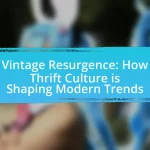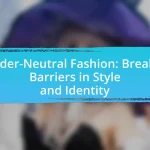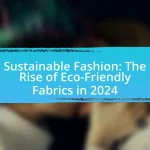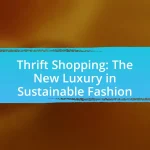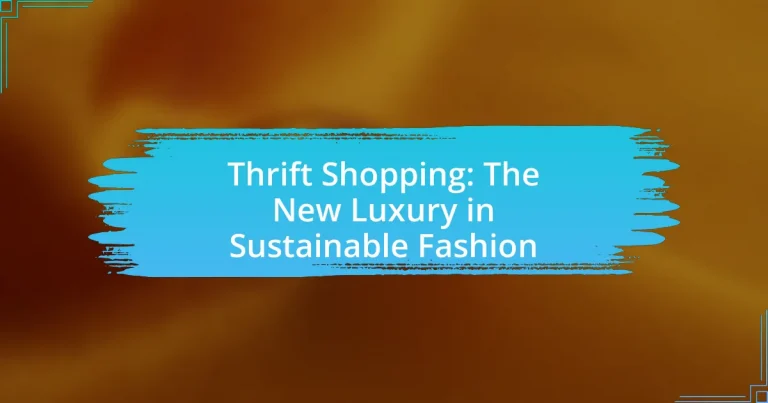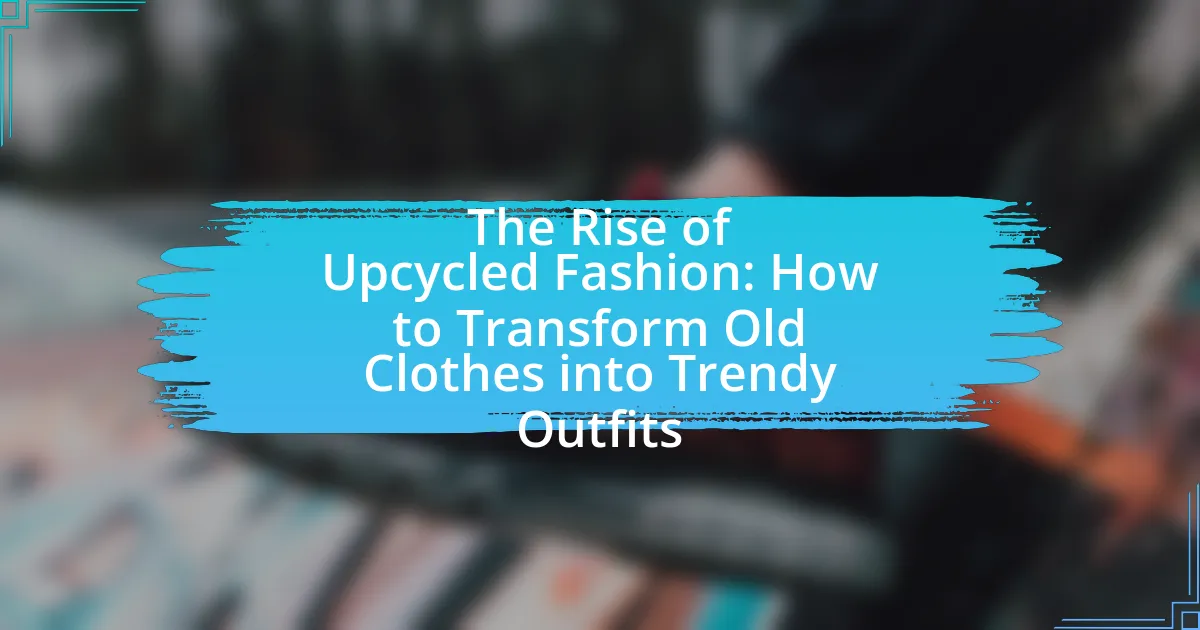Thrift shopping, the practice of purchasing second-hand items from thrift stores or charity shops, has emerged as a luxury trend in sustainable fashion. This article explores the evolution of thrift shopping from a budget-friendly option to a mainstream choice embraced by fashion enthusiasts and luxury brands, driven by increasing awareness of sustainability and environmental impact. Key factors contributing to this shift include changing consumer perceptions, the uniqueness and quality of thrifted items, and the significant environmental benefits associated with reducing waste and promoting a circular economy. The article also discusses best practices for thrift shopping, common misconceptions, and the financial advantages it offers consumers, highlighting its role in fostering creativity and individuality in personal style.

What is Thrift Shopping and Why is it Considered Luxury?
Thrift shopping is the practice of purchasing second-hand items, typically clothing, from thrift stores or charity shops. It is considered luxury because it offers unique, often high-quality items at a fraction of their original price, allowing consumers to access designer brands and vintage pieces that are no longer in production. The rise of thrift shopping aligns with sustainable fashion trends, as it promotes recycling and reduces waste, making it a socially responsible choice that appeals to environmentally conscious consumers. This shift in perception has elevated thrift shopping to a status symbol among fashion enthusiasts, who value individuality and sustainability over fast fashion.
How has thrift shopping evolved in the fashion industry?
Thrift shopping has evolved from a niche market for budget-conscious consumers to a mainstream trend embraced by fashion enthusiasts and luxury brands. Initially associated with second-hand goods and low-cost clothing, thrift shopping gained popularity as consumers became more aware of sustainability and the environmental impact of fast fashion. According to a 2021 report by ThredUp, the second-hand market is projected to reach $64 billion by 2024, highlighting a significant shift in consumer behavior towards sustainable fashion choices. This evolution is further evidenced by high-profile collaborations between thrift stores and luxury brands, as well as the rise of online thrift platforms, making second-hand shopping more accessible and desirable.
What historical factors contributed to the rise of thrift shopping?
The rise of thrift shopping can be attributed to several historical factors, including economic downturns, the environmental movement, and changing consumer attitudes towards sustainability. Economic recessions, such as the Great Depression in the 1930s and the 2008 financial crisis, led to increased interest in affordable clothing options, prompting consumers to seek thrift stores for budget-friendly alternatives. Additionally, the environmental movement gained momentum in the late 20th century, raising awareness about the negative impacts of fast fashion and encouraging consumers to adopt more sustainable shopping habits. This shift in consumer attitudes has been supported by statistics showing that second-hand shopping reduces waste and promotes recycling, further solidifying thrift shopping as a viable and responsible choice in the fashion industry.
How do consumer perceptions of thrift shopping differ today compared to the past?
Consumer perceptions of thrift shopping today are more positive and trend-focused compared to the past, where it was often associated with poverty or necessity. Currently, thrift shopping is viewed as a sustainable and fashionable choice, with many consumers embracing it as a way to express individuality and support eco-friendly practices. This shift is evidenced by the rise of social media influencers promoting thrifted fashion, as well as the increasing popularity of thrift stores, which reported a 25% growth in sales from 2013 to 2018, according to the Thrift Industry Association.
What defines luxury in the context of thrift shopping?
Luxury in the context of thrift shopping is defined by the uniqueness, quality, and heritage of items that are often rare or vintage. Thrift shopping allows consumers to access high-end brands and designer pieces at a fraction of their original price, emphasizing sustainability and individuality. The appeal of luxury in this setting is further enhanced by the thrill of the hunt for exclusive finds, which can include limited-edition items or pieces with historical significance. This shift towards thrift shopping as a luxury experience is supported by the growing trend of sustainable fashion, where consumers prioritize ethical consumption while still seeking high-quality, stylish clothing.
How do quality and uniqueness play a role in thrifted items?
Quality and uniqueness significantly enhance the appeal of thrifted items, making them desirable in the sustainable fashion market. High-quality thrifted items often feature durable materials and craftsmanship that surpass many contemporary fast-fashion products, which tend to prioritize cost over longevity. For instance, vintage clothing from reputable brands can retain their aesthetic and functional value over decades, attracting consumers who appreciate both sustainability and style.
Uniqueness is another critical factor; thrifted items often include one-of-a-kind pieces that cannot be found in mainstream retail stores. This distinctiveness allows individuals to express their personal style and stand out in a world of mass-produced fashion. According to a 2021 report by ThredUp, 70% of consumers believe that thrift shopping is a way to find unique items that reflect their individuality.
Together, quality and uniqueness not only contribute to the allure of thrifted items but also support the growing trend of sustainable fashion, encouraging consumers to make environmentally conscious choices while enjoying distinctive style options.
Why are thrifted items often seen as more exclusive than new luxury goods?
Thrifted items are often seen as more exclusive than new luxury goods because they are unique, limited in availability, and carry a sense of history. Unlike mass-produced luxury items, thrifted goods are typically one-of-a-kind finds that cannot be easily replicated, making them more desirable to consumers seeking individuality. Additionally, the scarcity of certain vintage or discontinued pieces enhances their perceived value, as evidenced by the growing market for second-hand luxury items, which has seen a 27% increase in sales from 2020 to 2021, according to ThredUp’s 2021 Resale Report. This trend reflects a shift in consumer preferences towards sustainable fashion, where the allure of thrifted items lies in their distinctiveness and the story they tell, further elevating their exclusivity compared to new luxury goods.
What are the environmental impacts of thrift shopping?
Thrift shopping significantly reduces environmental impacts by promoting the reuse of clothing and minimizing waste. By purchasing second-hand items, consumers help divert textiles from landfills, where they can take years to decompose. According to the Environmental Protection Agency, in 2018, approximately 11.3 million tons of textile waste were generated in the U.S., highlighting the importance of thrift shopping in mitigating this issue. Additionally, thrift shopping decreases the demand for new clothing production, which is resource-intensive and contributes to pollution. The fashion industry is responsible for about 10% of global carbon emissions, and by choosing thrifted items, consumers can lower their carbon footprint. Thus, thrift shopping plays a crucial role in fostering sustainable fashion practices and reducing overall environmental harm.
How does thrift shopping contribute to sustainable fashion practices?
Thrift shopping contributes to sustainable fashion practices by promoting the reuse of clothing, thereby reducing waste and the demand for new garment production. By purchasing second-hand items, consumers extend the lifecycle of clothing, which helps to minimize the environmental impact associated with manufacturing, such as water usage and carbon emissions. According to a report by the Ellen MacArthur Foundation, extending the life of clothes by just nine months can reduce their carbon, water, and waste footprints by 20-30%. This demonstrates that thrift shopping not only supports individual sustainability efforts but also plays a significant role in the broader movement towards a circular economy in fashion.
What are the benefits of reducing waste through thrift shopping?
Reducing waste through thrift shopping significantly benefits the environment by minimizing landfill contributions and conserving resources. Thrift shopping extends the lifecycle of clothing, which reduces the demand for new production that often involves resource-intensive processes. According to the Environmental Protection Agency, textile waste accounts for approximately 9.2 million tons annually in the U.S., highlighting the importance of reusing garments to mitigate this issue. Additionally, thrift shopping promotes a circular economy, where items are reused and recycled, further decreasing environmental impact. This practice not only supports sustainability but also fosters community engagement and economic savings for consumers.

How Does Thrift Shopping Promote Sustainable Fashion?
Thrift shopping promotes sustainable fashion by extending the lifecycle of clothing and reducing waste. When consumers purchase second-hand items, they decrease the demand for new production, which is responsible for significant environmental impacts, including water usage and carbon emissions. According to a report by the Ellen MacArthur Foundation, the fashion industry is responsible for 10% of global carbon emissions, and thrift shopping helps mitigate this by keeping garments in circulation longer. Additionally, thrift shopping supports a circular economy, where resources are reused and recycled, further contributing to sustainability efforts in the fashion industry.
What are the key principles of sustainable fashion?
The key principles of sustainable fashion include ethical production, resource conservation, and social responsibility. Ethical production emphasizes fair labor practices and transparency in the supply chain, ensuring that workers are treated fairly and compensated adequately. Resource conservation focuses on minimizing waste and utilizing sustainable materials, such as organic cotton or recycled fabrics, to reduce environmental impact. Social responsibility involves promoting inclusivity and supporting local communities, which can enhance the overall sustainability of the fashion industry. These principles are essential for creating a fashion system that respects both people and the planet.
How does thrift shopping align with these principles?
Thrift shopping aligns with the principles of sustainability and ethical consumption by promoting the reuse of clothing, thereby reducing waste and the demand for new production. This practice directly contributes to environmental conservation, as the fashion industry is responsible for significant pollution and resource depletion. According to the Ellen MacArthur Foundation, the fashion industry generates over 92 million tons of waste annually, highlighting the importance of alternatives like thrift shopping that extend the lifecycle of garments. By choosing second-hand items, consumers actively participate in a circular economy, which emphasizes the value of reusing and recycling materials, thus supporting sustainable fashion initiatives.
What role does consumer behavior play in sustainable fashion?
Consumer behavior significantly influences sustainable fashion by driving demand for eco-friendly products and practices. As consumers become more aware of environmental issues, their purchasing decisions increasingly favor brands that prioritize sustainability, leading to a shift in the fashion industry towards more responsible practices. For instance, a 2021 survey by McKinsey & Company found that 67% of consumers consider the use of sustainable materials important when making fashion purchases. This growing preference encourages brands to adopt sustainable practices, such as using recycled materials and reducing waste, ultimately shaping the market dynamics in favor of sustainable fashion.
How can thrift shopping reduce the carbon footprint of the fashion industry?
Thrift shopping can significantly reduce the carbon footprint of the fashion industry by extending the lifecycle of clothing and minimizing the demand for new production. When consumers purchase second-hand items, they decrease the need for manufacturing new garments, which is responsible for a substantial portion of greenhouse gas emissions; the fashion industry contributes approximately 10% of global carbon emissions. Additionally, thrift shopping diverts textiles from landfills, where they would otherwise decompose and release methane, a potent greenhouse gas. By choosing thrifted items, consumers actively participate in a circular economy, promoting sustainability and reducing overall environmental impact.
What statistics support the environmental benefits of thrift shopping?
Thrift shopping significantly reduces environmental impact, with statistics indicating that purchasing second-hand clothing can save approximately 2,000 gallons of water per item compared to buying new. Additionally, a study by the Environmental Protection Agency reveals that thrift shopping can divert over 25 billion pounds of textiles from landfills annually, thereby reducing waste and greenhouse gas emissions. Furthermore, the resale market is projected to grow to $64 billion by 2024, highlighting a shift towards sustainable consumption patterns that prioritize environmental benefits.
How does the lifecycle of thrifted clothing compare to fast fashion?
The lifecycle of thrifted clothing is significantly longer and more sustainable compared to fast fashion. Thrifted clothing typically undergoes multiple ownerships, extending its usability and reducing waste, while fast fashion items are often worn only a few times before being discarded, contributing to a high turnover rate and environmental degradation. According to the Ellen MacArthur Foundation, the fast fashion industry produces over 92 million tons of waste annually, whereas thrifted clothing promotes a circular economy by encouraging reuse and recycling, thereby minimizing landfill contributions and resource consumption.

What are the Best Practices for Thrift Shopping?
The best practices for thrift shopping include researching local thrift stores, setting a budget, and being patient while browsing. Researching local thrift stores helps identify those with high-quality items and frequent inventory turnover, increasing the chances of finding valuable pieces. Setting a budget prevents overspending and encourages thoughtful purchases. Patience is essential, as thrift shopping often requires time to sift through various items to discover hidden gems. Additionally, checking for quality and fit ensures that the items purchased are both functional and stylish, aligning with sustainable fashion principles.
How can shoppers maximize their thrift shopping experience?
Shoppers can maximize their thrift shopping experience by researching store locations and inventory online before visiting. This approach allows shoppers to identify which stores have the best selections and specific items they are looking for, increasing the likelihood of finding high-quality goods. According to a study by the Thrift Store Association, 70% of thrift shoppers report that planning their visits leads to more successful finds, as they can focus on stores that align with their style and needs. Additionally, shoppers should visit stores frequently, as inventory changes regularly, and being a regular can lead to discovering unique items.
What tips should be followed when searching for quality items?
When searching for quality items, prioritize examining the material and craftsmanship. High-quality items often use durable fabrics like wool, silk, or high-grade cotton, and feature well-constructed seams and finishes. Additionally, check for brand reputation; established brands typically maintain higher quality standards. Research indicates that items from reputable brands often last longer and perform better, as noted in studies on consumer behavior and product longevity. Lastly, inspect for signs of wear and tear, as quality items should show minimal signs of previous use.
How can shoppers identify valuable pieces in thrift stores?
Shoppers can identify valuable pieces in thrift stores by researching brand quality, understanding fabric types, and recognizing unique designs. High-quality brands often retain value, so familiarity with reputable labels can guide shoppers. Additionally, natural fabrics like wool, silk, and cotton typically indicate better quality compared to synthetic materials. Unique designs or vintage items can also signify value, as they may be sought after by collectors. For instance, certain vintage clothing from well-known designers can fetch high prices in resale markets, validating the importance of brand and design recognition in thrift shopping.
What are common misconceptions about thrift shopping?
Common misconceptions about thrift shopping include the belief that thrift stores only sell low-quality or outdated items. In reality, many thrift shops offer a wide range of high-quality, gently used clothing and accessories, including designer brands. According to a 2021 report by ThredUp, 70% of consumers believe that thrift shopping is a sustainable way to shop, highlighting its growing acceptance as a viable fashion choice. Another misconception is that thrift shopping is time-consuming; however, many stores are organized and offer online shopping options, making it easier for consumers to find what they need quickly.
Why do some people believe thrift shopping is inferior to buying new?
Some people believe thrift shopping is inferior to buying new due to perceptions of quality and status. Many individuals associate new items with higher quality, believing that second-hand goods may be worn or damaged, which can lead to a stigma around thrift shopping. Additionally, societal norms often equate new purchases with success and wealth, making thrift shopping seem less desirable. Research indicates that consumer attitudes towards thrift shopping can be influenced by cultural values that prioritize brand new items as symbols of prestige and social standing.
How can these misconceptions be addressed to promote thrift shopping?
Misconceptions about thrift shopping can be addressed through education and awareness campaigns that highlight the benefits of sustainable fashion. By providing information on the environmental impact of fast fashion, such as the fact that the fashion industry is responsible for 10% of global carbon emissions, campaigns can shift perceptions. Additionally, showcasing the quality and uniqueness of thrifted items can counter the belief that second-hand goods are inferior. For instance, studies show that thrift shopping can save consumers up to 70% compared to retail prices, making it an economically attractive option. Engaging influencers and community events can further promote thrift shopping as a trendy and responsible choice, thereby changing misconceptions and encouraging participation.
What are the benefits of incorporating thrift shopping into your wardrobe?
Incorporating thrift shopping into your wardrobe offers significant benefits, including cost savings, unique fashion finds, and environmental sustainability. Thrift shopping allows individuals to purchase clothing at a fraction of the retail price, often saving up to 70% compared to new items. Additionally, thrift stores frequently carry one-of-a-kind pieces that contribute to a distinctive personal style, setting shoppers apart from mainstream fashion trends. Environmentally, thrift shopping promotes sustainability by reducing waste; according to the Environmental Protection Agency, textile recycling and reuse can divert millions of tons of clothing from landfills each year, thereby minimizing the fashion industry’s carbon footprint.
How does thrift shopping encourage creativity in personal style?
Thrift shopping encourages creativity in personal style by providing unique, one-of-a-kind items that are not mass-produced. This variety allows individuals to experiment with different aesthetics and combinations, fostering a sense of individuality. Studies show that engaging with diverse clothing options can enhance personal expression; for instance, a 2020 survey by ThredUp found that 70% of thrift shoppers feel more confident in their style choices. By curating outfits from eclectic pieces, thrift shoppers can develop a distinctive look that reflects their personality, setting them apart from mainstream fashion trends.
What financial advantages does thrift shopping offer to consumers?
Thrift shopping offers significant financial advantages to consumers by providing access to high-quality items at a fraction of their original retail prices. Consumers can save up to 70% or more on clothing, furniture, and household goods compared to buying new. This cost-effectiveness allows individuals to stretch their budgets further, enabling them to purchase more items or invest in other financial priorities. Additionally, thrift shopping often includes unique and vintage pieces that can appreciate in value, offering potential resale opportunities.
